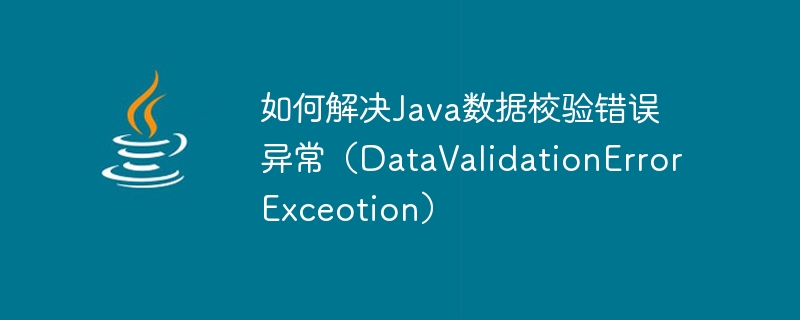

How to solve Java data validation error exception (DataValidationErrorException)
In Java programming, data verification is a very important part. It ensures that the data received by our program is legal and meets our expectations. However, sometimes errors may occur during the data verification process, which requires us to handle the Data Validation Error Exception (DataValidationErrorException). This article will introduce how to solve Java data validation error exceptions and provide code examples to help readers better understand.
Java provides try-catch statements to handle exceptions. When handling data verification error exceptions, we can place code that may throw exceptions in the try block, and catch and handle the exception in the catch block. The following code shows a simple exception handling example:
try {
// 数据校验代码
} catch (DataValidationErrorException e) {
// 处理异常的代码
}In the catch block, we can handle exceptions based on specific business needs. For example, we can print exception stack information or return an error message to the user.
In addition to the standard exceptions provided by Java, we can also customize data verification error exceptions. By customizing exceptions, we can better communicate exception information to other developers and better differentiate between different data validation errors. The following code shows how to customize a data verification error exception:
public class DataValidationErrorException extends RuntimeException {
public DataValidationErrorException(String message) {
super(message);
}
}In this custom exception class, we inherit the RuntimeException class and override the constructor. In this way, we can pass in the exception information when an exception is thrown and print or display it to the developer.
In actual business, the logic of data verification may be quite complex. The following is a simple data verification example to verify whether the age entered by the user meets the regulations:
public static void validateAge(int age) throws DataValidationErrorException {
if (age < 0 || age > 120) {
throw new DataValidationErrorException("年龄必须在0到120之间");
}
}
public static void main(String[] args) {
int age = -10;
try {
validateAge(age);
} catch (DataValidationErrorException e) {
System.out.println(e.getMessage());
}
}In this example, we first define a validateAge method to verify whether the age is legal. If the age is less than 0 or greater than 120, a data verification error exception is thrown, and the exception information is set to "Age must be between 0 and 120". In the main method, we call the validateAge method and use the try-catch statement to catch and handle the exception. If an exception is caught, we print out the exception information.
Through the above examples, we can see how to use exception handling in Java to solve data verification error exceptions. This method can effectively handle exceptions and improve the robustness and fault tolerance of the program. At the same time, we can also use custom exceptions to better distinguish different data verification errors and convey exception information to other developers. I hope this article can help readers better understand and apply the relevant knowledge of exception handling.
The above is the detailed content of How to solve Java data validation error exception (DataValidationErrorExceotion). For more information, please follow other related articles on the PHP Chinese website!
 The difference between currentregion and usedrange
The difference between currentregion and usedrange
 Win11 skips the tutorial to log in to Microsoft account
Win11 skips the tutorial to log in to Microsoft account
 Where to watch Douyin live replays
Where to watch Douyin live replays
 What are the static code checking tools?
What are the static code checking tools?
 What to do if chrome cannot load plugins
What to do if chrome cannot load plugins
 What are the mobile operating systems?
What are the mobile operating systems?
 How to buy Bitcoin
How to buy Bitcoin
 How to solve mysql query error error
How to solve mysql query error error




